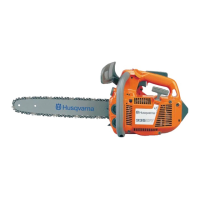
Do you have a question about the Husqvarna 335XPT California and is the answer not in the manual?
Essential protective gear for chainsaw operation, including helmet, hearing protection, glasses, gloves, and trousers.
Details safety features of the saw and their inspection/maintenance for safe operation.
Ensures the brake band has adequate thickness for proper functioning.
Verifies the front hand guard is undamaged and securely anchored for activation.
Guidelines on using recommended equipment, sharpening, tensioning, lubrication for performance and safety.
Importance of sharp chains, cutting teeth structure, and key factors for proper sharpening.
Step-by-step guide on how to sharpen cutting teeth using a round file and file gauge.
Guidance on reducing raker clearance to maintain cutting performance and avoid kickback.
Information on automatic chain lubrication, recommended oils, and viscosity considerations.
Defines kickback as a sudden, violent reaction when the kickback zone of the bar touches an object.
Key safety practices to avoid accidents, including PPE, avoiding kickback situations, and checking safety functions.
Emphasizes holding the saw firmly with both hands for control and minimizing kickback effects.
Highlights kickback risks during limbing and the importance of stable footing and concentration.
Warns against operating the saw when tired, under the influence of alcohol, or medication affecting judgment.
Covers essential safety steps before starting the saw, including chain brake activation and clear area.
Provides critical precautions for handling fuel and chain oil to prevent fire hazards.
General rules for safe operation, including checking the work area and ensuring no one is at risk.
Advises extreme caution when cutting tensioned wood to prevent sudden spring-back.
Recommendations for using full throttle, reducing speed to idle, and understanding pull/push strokes.
Ensuring the bar does not get stuck in the cut to avoid accidents.
Maintaining a safe distance (2.5 tree lengths) from the felling area for personnel safety.
Factors influencing felling direction and the importance of judging the tree's natural fall.
Step-by-step instructions for correctly fitting the guide bar and chain onto the chainsaw.
Guidance on correctly mixing gasoline and two-stroke oil, and requirements for each.
Safety measures to take when refuelling the chainsaw to minimize fire risk.
Step-by-step instructions for starting a cold or warm engine, including chain brake activation.
Simple procedure for stopping the engine by moving the ignition switch to the stop position.
Detailed information on carburetor function, adjustment, and troubleshooting for optimal performance.
Instructions for maintenance, repair, and assembly of the chainsaw's starter device.
Procedures for cleaning, checking, and replacing the air filter to ensure proper engine operation.
Guidance on spark plug maintenance, including cleaning, gap adjustment, and replacement.
How to adjust the oil pump to control the flow of chain oil for proper lubrication.
Information on the components and cleaning of the cooling system to prevent overheating.
Routine checks performed daily to ensure the safe and proper operation of the chainsaw.
Scheduled maintenance tasks to be performed weekly for optimal chainsaw performance and longevity.
Scheduled maintenance tasks to be performed monthly for comprehensive chainsaw upkeep.
Details on cylinder volume, bore, stroke, idle speed, and power output.
Lists combinations investigated for kickback requirements and safety.
Explains EPA and Husqvarna emission control system warranty for small nonroad engines.
Outlines the owner's responsibility for maintenance and proper use to maintain warranty coverage.